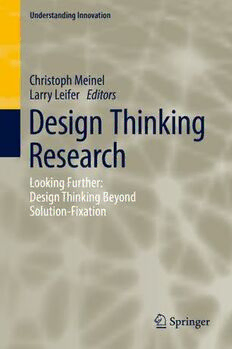Table Of ContentUnderstanding Innovation
Christoph Meinel
Larry Leifer Editors
Design Thinking
Research
Looking Further:
Design Thinking Beyond
Solution-Fixation
Understanding Innovation
Serieseditors
ChristophMeinel
Potsdam,Germany
LarryLeifer
Stanford,USA
Moreinformationaboutthisseriesathttp://www.springer.com/series/8802
(cid:129)
Christoph Meinel Larry Leifer
Editors
Design Thinking Research
Looking Further: Design Thinking Beyond
Solution-Fixation
Editors
ChristophMeinel LarryLeifer
HassoPlattnerInstituteforDigital StanfordUniversity
Engineering Stanford,CA,USA
UniversityofPotsdam
Potsdam,Germany
ISSN2197-5752 ISSN2197-5760 (electronic)
UnderstandingInnovation
ISBN978-3-319-97081-3 ISBN978-3-319-97082-0 (eBook)
https://doi.org/10.1007/978-3-319-97082-0
LibraryofCongressControlNumber:2018957128
©SpringerNatureSwitzerlandAG2019
Thisworkissubjecttocopyright.AllrightsarereservedbythePublisher,whetherthewholeorpartofthe
materialisconcerned,specificallytherightsoftranslation,reprinting,reuseofillustrations,recitation,
broadcasting,reproductiononmicrofilmsorinanyotherphysicalway,andtransmissionorinformation
storageandretrieval,electronicadaptation,computersoftware,orbysimilarordissimilarmethodology
nowknownorhereafterdeveloped.
Theuseofgeneraldescriptivenames,registerednames,trademarks,servicemarks,etc.inthispublication
doesnotimply,evenintheabsenceofaspecificstatement,thatsuchnamesareexemptfromtherelevant
protectivelawsandregulationsandthereforefreeforgeneraluse.
The publisher, the authors and the editors are safe to assume that the advice and information in this
bookarebelievedtobetrueandaccurateatthedateofpublication.Neitherthepublishernortheauthorsor
theeditorsgiveawarranty,expressorimplied,withrespecttothematerialcontainedhereinorforany
errorsoromissionsthatmayhavebeenmade.Thepublisherremainsneutralwithregardtojurisdictional
claimsinpublishedmapsandinstitutionalaffiliations.
ThisSpringerimprintispublishedbytheregisteredcompanySpringerNatureSwitzerlandAG
Theregisteredcompanyaddressis:Gewerbestrasse11,6330Cham,Switzerland
Foreword
Complexity grows ubiquitously in our world, and the resultant challenges are
impossible to ignore. New developments in digital technologies often suggest and
frequently demand making changes—sometimes radical—to how products, tools,
and services could or should function, how we collaborate and interact with cus-
tomersandpartners,andhowweorganizeprocessesandbusiness.Inordertomove
forwardeffectively,itisnecessaryforustothinkdifferently,departingfromhabitual
andtraditionalwaysofthinking.Designthinkinghasbeenadoptedandpracticedby
individuals and organizations in increasing numbers as a powerful framework to
fosterinnovationinproducts,services,andoperations,andmorerecentlyonstrategy
andcreatingculturesofinnovation.
Asinterestandexperienceindesignthinkinghavegrown,aswellasitsapplica-
tion to new and diverse challenges, there is an increasing need to deepen our
understanding of how and why design thinking works: what are the factors that
makeitmoresuccessfulthanotherapproaches,andwhatarethereasonsitcanfail?
Theseareamongthedrivingquestionsthatfuelmycontinuousinterestandsupport
for meticulous and conscientious research in the field through the Hasso Plattner
Design Thinking Research Program, a research initiative conducted jointly by the
HassoPlattnerInstituteofDesignatStanfordUniversityinCaliforniaandtheHasso
PlattnerInstitute(HPI)forDigitalEngineeringinPotsdam,Germany.
Overthecourseofnearlytenyearsofgroundbreakingresearch,ourunderstanding
ofdesignthinkinghasbroadenedanddeepenedinanunprecedentedmanner.Since
theimplementationoftheDesignThinkingResearchProgramin2008,researchers
ontwocontinentshaveconductedover100studiesexamining,detailing,andmaking
senseofdesignthinkinginitsmanyforms.Wenowhaveanestimablebodyofnew
knowledgeconcerningteamdynamics,thecharacteristicsandmechanismsofeffec-
tive design thinking tools, and the application of design thinking in organizational
contexts.Newtoolsandmethodsbasedontheknowledgeandinsightscreatedbythe
programarelayingafoundationforinformed,empiricallybasedpracticethatyields
greater impact. It is incumbent upon the research community to channel the new
v
vi Foreword
knowledgewehavecreatedintoimprovedcontentforteachingandlearningdesign
thinkinginallHPIcommunities.
New discoveriesand insights,newlydeveloped approaches,andtoolsindesign
thinkingshouldbeavailabletoallwhoseektoadvance,drive,andsupportinnovation
andinnovativeculturefororganizationsorforindividualsmakingsocialandcultural
change. In light of this, it is essential for new design thinking knowledge and
content—studies, workshops, frameworks, exercises, and tools—to be available
andaccessibletostudentsandprofessionals,toexperts,andtothosejuststartingout.
LastyearthetenthanniversaryofthefoundingoftheSchoolofDesignThinking
at Hasso Plattner Institute in Potsdam was celebrated at the second d.confestival.
ScholarsoftheDesignThinkingResearchProgramcomplementedthefestivitiesby
running an enthusiastically attended “Design Thinking Research Lab” in the event
space. Here, visitors learned not only about new contributions to and insights into
design thinking, but also about how research is conducted and why it is a force of
relevantchangeinourcommunities.
Atthismoment,youholdinyourhandsanotherwayofbringingourfindingsto
innovators everywhere: the ninth volume of our series on design thinking research
presentsthecomprehensivecollectionofresearchstudiescarriedoutbyscholarsof
boththeHassoPlattnerInstituteinPotsdamandatStanfordUniversity.Inadditionto
providingthefindingsofrecentprojects,thisvolumepresentsathought-provoking
historical perspective on design thinking as a creative practice. Now in its second
fundingperiod,theDesignThinkingResearchProgramhascultivatedadiverseand
growing community that gives place to rich exchanges between current doctoral
candidates,alumni,researchers,andpractitionersfromamyriadofdisciplines.These
exchangesbringnewperspectives,depth,andlastingvaluetonotonlytheprogram
andtoitsresearchers,buttodesignthinkingitself.
Thesynthesisofmultipleperspectives—whichresultsfromteamsofpeoplefrom
diversedisciplines,fromresearchandfrompractice,collaboratingonthesame,often
wickedchallenge—constitutesoneofthefundamentalbenefitsofdesignthinking.In
thisenterpriseofdesignthinkingresearch,weencourageyoutoreachoutandinvite
curious innovators of all kinds to work together, to experiment and learn, and to
focus on broadening and deepening our practice and understanding of design
thinkingandtheimpactitcanbringtobenefittheworld.
PaloAlto,CA HassoPlattner
Winter2017/2018
Contents
LookingFurther:DesignThinkingBeyondSolution-Fixation. . . . . . . . 1
LarryLeiferandChristophMeinel
TheoreticalFoundationsofDesignThinking. . . . . . . . . . . . . . . . . . . . . 13
JuliaP.A.vonThienen,WilliamJ.Clancey,andChristophMeinel
PartI UnderstandingSuccessFactorsofDesignThinking
EmotionsAlongtheDesignThinkingProcess. . . . . . . . . . . . . . . . . . . . . 41
BenediktEwald,AxelMenning,ClaudiaNicolai,andUlrichWeinberg
MeasuringDesignThinkingPracticeinContext. . . . . . . . . . . . . . . . . . . 61
AdamRoyalty,HelenChen,BernardRoth,andSheriSheppard
MakingUseofInnovationSpaces:TowardsaFramework
ofStrategizingSpatialInterventions. . . . . . . . . . . . . . . . . . . . . . . . . . . . 75
MarieKlooker,MartinSchwemmle,ClaudiaNicolai,andUlrichWeinberg
PartII ExploringtheDigitalPotential:Teaching,Research
andOrganizationalApproaches
AnIterativeApproachtoOnlineCourseDesign:ImprovingaDesign
ResearchMOOC. . . . . . . . . . . . . . . . . . . . . . . . . . . . . . . . . . . . . . . . . . 99
KarenvonSchmieden,LenaMayer,ManaTaheri,andChristophMeinel
CrowdResearch:OpenandScalableUniversityLaboratories. . . . . . . . 113
RajanVaish,Snehalkumar(Neil)S.Gaikwad,GezaKovacs,AndreasVeit,
RanjayKrishna,ImanolArrietaIbarra,CameliaSimoiu,MichaelWilber,
SergeBelongie,SharadC.Goel,JamesDavis,andMichaelS.Bernstein
vii
viii Contents
RedesigningSocialOrganizationforAcceleratedInnovationintheNew
DigitalEconomy:ADesignThinkingPerspective. . . . . . . . . . . . . . . . . . 143
AdeMabogunje,NeerajSonalkar,andLarryLeifer
PartIII DesignThinkinginPractice
NewWaysofDataEntryinDoctor-PatientEncounters. . . . . . . . . . . . . 159
MatthiasWenzel,AnjaPerlich,JuliaP.A.vonThienen,
andChristophMeinel
DesignThinkingPainManagement:ToolstoImproveHuman-Centered
CommunicationBetweenPatientsandProviders. . . . . . . . . . . . . . . . . . 179
NicholasBerte,LaurenAquinoShluzas,BardiaBeigi,MosesAlbaniel,
MartinS.Angst,andDavidPickham
InnoDev:ASoftwareDevelopmentMethodologyIntegratingDesign
Thinking,ScrumandLeanStartup. . . . . . . . . . . . . . . . . . . . . . . . . . . . 199
FranziskaDobrigkeit,DaniellydePaula,andMatthiasUflacker
TowardsExploratorySoftwareDesignEnvironments
fortheMulti-DisciplinaryTeam. . . . . . . . . . . . . . . . . . . . . . . . . . . . . . . 229
PatrickRein,MarcelTaeumel,andRobertHirschfeld
“IKnowItWhenISeeIt”:HowExpertsandNovicesRecognize
GoodDesign. . . . . . . . . . . . . . . . . . . . . . . . . . . . . . . . . . . . . . . . . . . . . . 249
KeslerTannerandJamesLanday
Looking Further: Design Thinking Beyond
Solution-Fixation
LarryLeiferandChristophMeinel
Abstract Inthepursuitofbreakthroughinnovation,itisnecessarytorecognizethat
most, if not all, respective disciplines exhibit tendencies for “solution-fixation.”
When problems appear, the historical value of designers and managers has been
associated with an ability to swiftly recognize, properly mobilize, and solve them.
The Hasso Plattner Design Thinking Research Program (HPDTRP) redirects ana-
lytical and generative attention elsewhere: to the development and nurturing of a
problem-orientedmindset.
1 Fixations and Orientations
In the pursuit of breakthrough innovation, it is necessary torecognize that most, if
notall,respectivedisciplinesexhibittendenciesfor“solution-fixation.”Whenprob-
lemsappear,thehistoricalvalueofdesignersandmanagershasbeenassociatedwith
an ability to swiftly recognize, properly mobilize, and solve them. Such assured
action fulfills the general expectations of the world at large, and this prevailing
behavior is further nurtured by both urgency found on the front lines of design
practiceandincreasingdemandforappliedresearch.
The Hasso Plattner Design Thinking Research Program (HPDTRP) redirects
analytical and generative attention elsewhere, while reappropriating the prevailing
mindsetwhennecessary.Wefindgreatervalueinthedevelopmentandnurturingof
a problem-oriented mindset to best quell prevailing solution-fixation practices that
continue to drive some disciplinary specific practices today. Through our engage-
mentwithfoundproblems,anynaturaltendencytosolveisfirstsuspendedtobetter
interrogate and reframe problems for end-user gain. This temporary suspension of
L.Leifer(*)
StanfordCenterforDesignResearch,StanfordUniversity,Stanford,CA,USA
e-mail:[email protected]
C.Meinel
HassoPlattnerInstituteforDigitalEngineering,UniversityofPotsdam,Potsdam,Germany
e-mail:[email protected]
©SpringerNatureSwitzerlandAG2019 1
C.Meinel,L.Leifer(eds.),DesignThinkingResearch,UnderstandingInnovation,
https://doi.org/10.1007/978-3-319-97082-0_1

